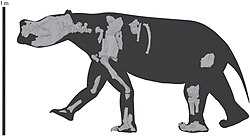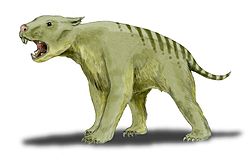| Ambulator Temporal range: Pliocene, | |
|---|---|
 | |
| Scientific classification | |
| Domain: | Eukaryota |
| Kingdom: | Animalia |
| Phylum: | Chordata |
| Class: | Mammalia |
| Infraclass: | Marsupialia |
| Order: | Diprotodontia |
| Family: | † Diprotodontidae |
| Genus: | † Ambulator van Zoelen et al., 2023 |
| Species: | †A. keanei |
| Binomial name | |
| †Ambulator keanei (Stirton, 1967) | |
Ambulator is an extinct genus of marsupials belonging to the family Diprotodontidae. It contains one species, A. keanei, whose remains were found in the Pliocene-aged Tirari Formation of South Australia. A. keanei was previously included in the genus Zygomaturus , but was moved to the new genus Ambulator in 2023. Features of its limbs suggest that Ambulator was better adapted to quadrupedal walking than earlier diprotodontids. [1]

